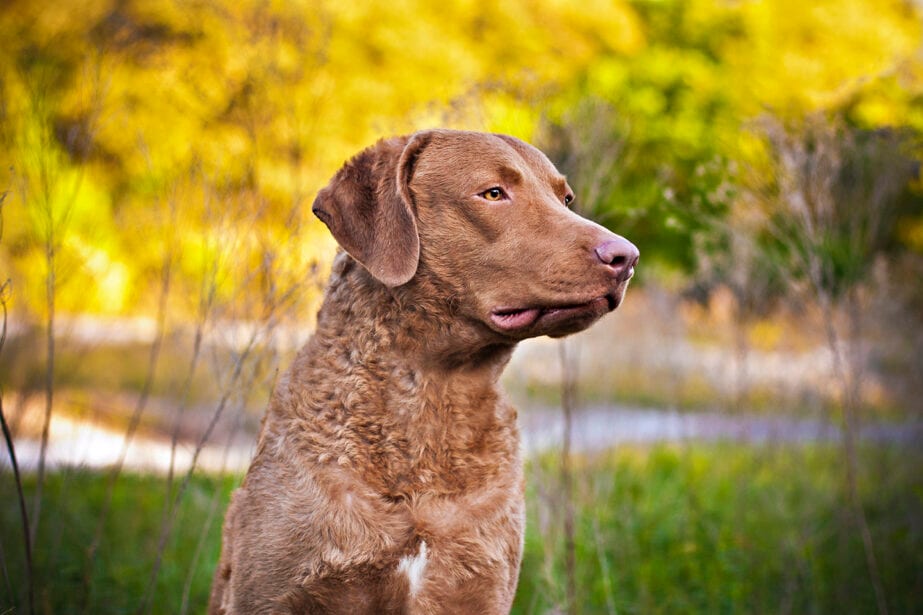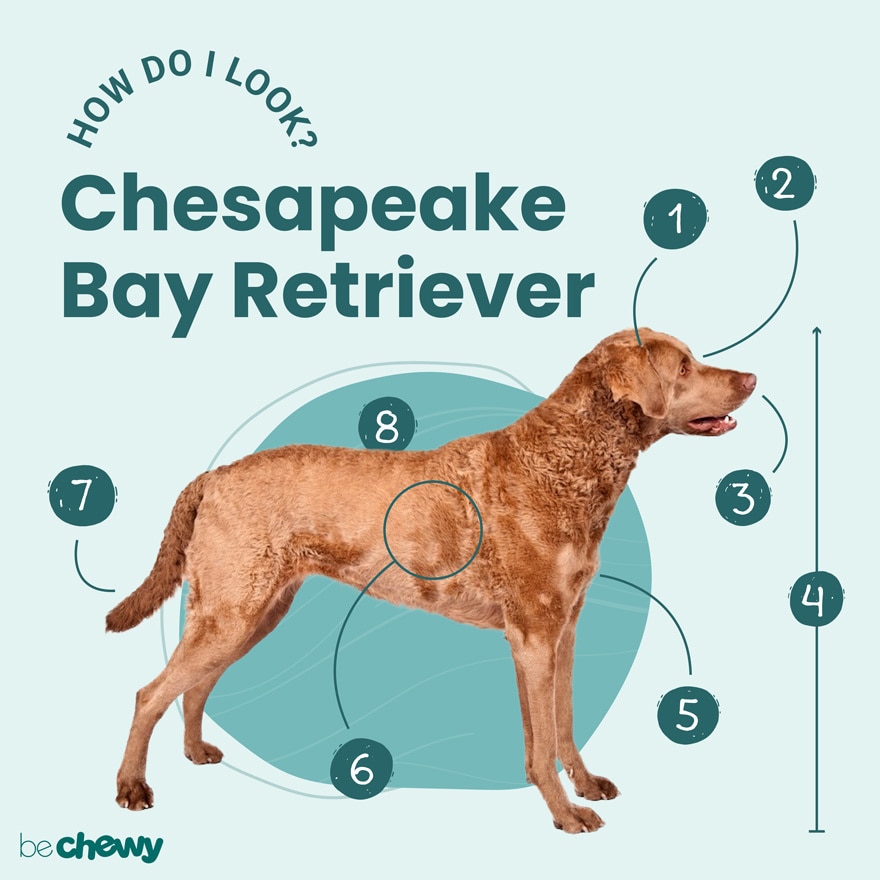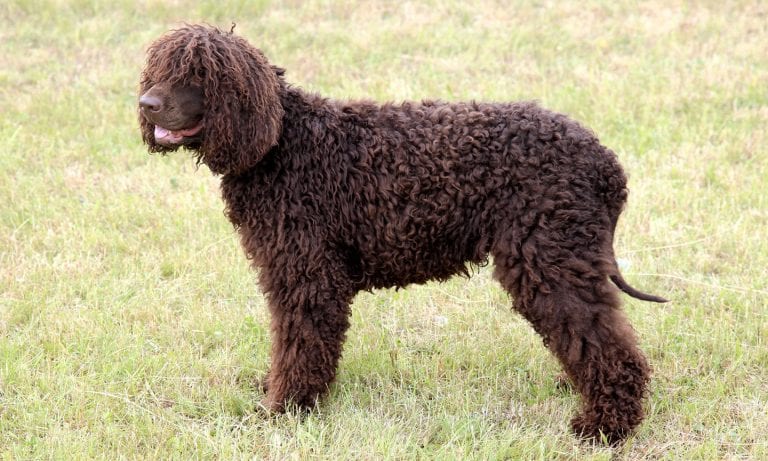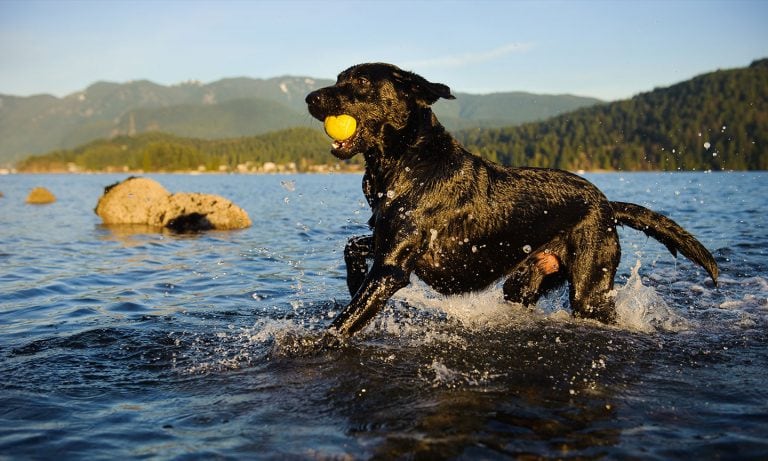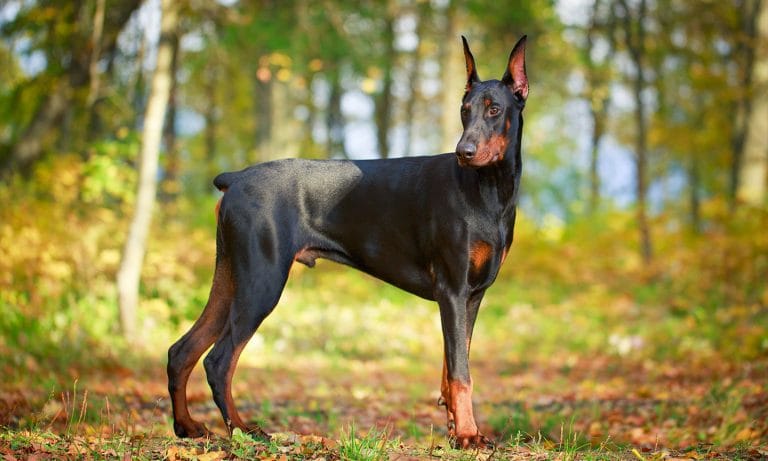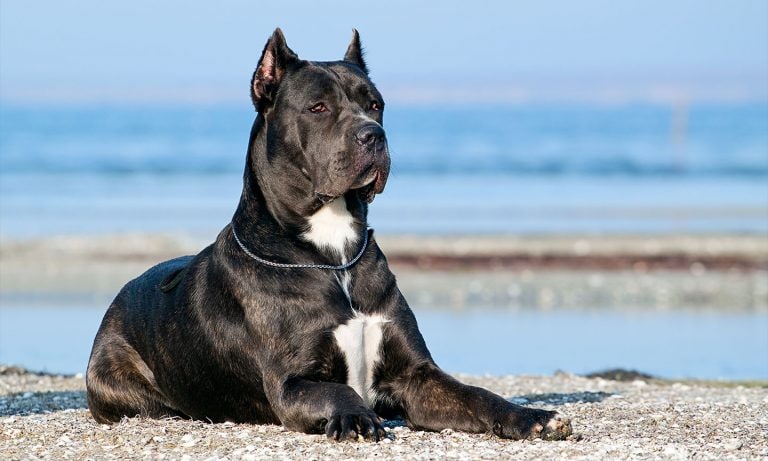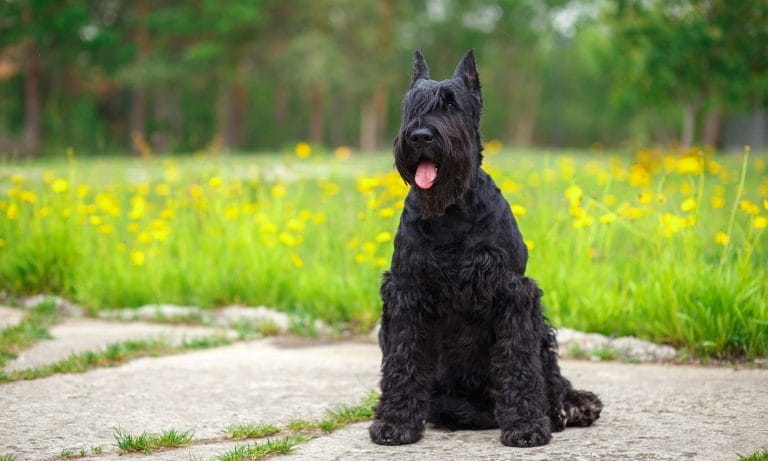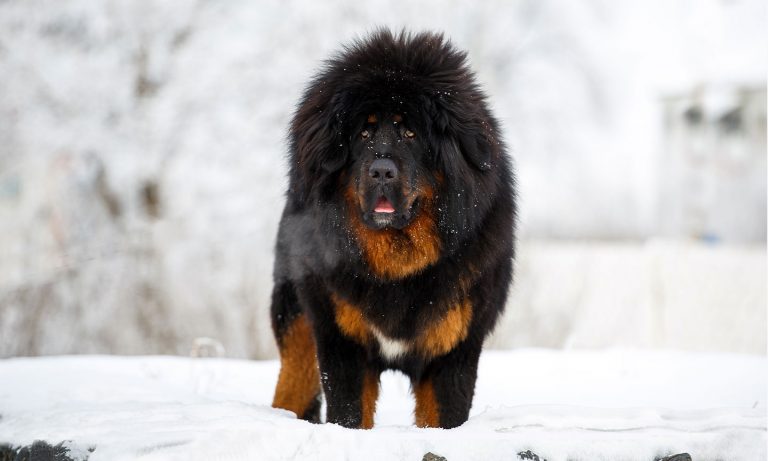In a high school comedy with an all-canine cast, the Chesapeake Bay Retriever (aka Chessie) would play the handsome jock with a heart of gold. Smart, athletic and fiercely loyal, this muscular breed would do anything to protect their loved ones. Great companions for pet parents who are always on the go, high-energy Chessies are happiest outside running, playing with toys, or, better still, swimming the day away. Hunting dogs at heart, these sporty pups have the stamina to fetch that ball for hours. The Great Outdoors are calling, so be prepared to answer with your Chessie by your side—this breed just might answer the call for you both.
Breed Snapshot
Temperament:
SportyProtectiveWarm-HeartedCoat Color:
BrownDark BrownDark DeadgrassDeadgrassLight BrownLight DeadgrassSedgeTan
Best For
Chesapeake Bay Retrievers, loyal and intelligent, need regular grooming and ample exercise. They thrive in active homes with experienced pet parents who enjoy outdoor activities and can provide mental stimulation.
Chesapeake Bay Retriever Temperament
Pet parents who think there is just too much life to be lived to stay indoors will find their canine soulmate in the Chesapeake Bay Retriever dog. With energy levels through the roof, these dogs thrive when they can accompany you on outdoor adventures.
Unlike other retriever breeds who would gladly welcome anyone over and pour them a cup of coffee if they could (we’re looking at you, Labs), Chessies can be reserved around strangers. Couple that with their strong bark and powerful physique, and strangers and nosy neighbors might take pause.
Chessies have a high drive to hunt and retrieve, but they can be good with kids as long as everyone respects each other’s boundaries. (So teach your kids how to respectfully interact with dogs, and vice versa.) They are also prone to resource guarding, especially with their toys around young children—a behavior you must correct immediately for a harmonious co-existence. Raising a Chesapeake Bay Retriever with kids and other dogs from puppyhood offers everyone the best chance to get along.
Chesapeake Bay Retrievers are affectionate and loyal to their family—and sometimes don’t want to share their toys, chews or retrievals. They are considered the most strong-willed of the retriever breeds, and their intelligence and independent streak may test the patience of a new pet parent, though it shouldn’t stump those willing to put in the training time. While Chessies love having an active job, they are also content to bond with their pet parents through active play and enrichment activities.
How to Care for a Chesapeake Bay Retriever
Chesapeake Bay Retriever dogs look like the picture of athletic elegance and require your moderate effort to keep them looking that way. Chessies need a ton of daily exercise, a balanced diet and a regular grooming and nail trimming routine to maintain their movie-star good looks and agreeable disposition.
Chesapeake Bay Retriever Health
Chessies have a life expectancy of 10 to 13 years, although they are prone to some health issues. Knowing about these potential health problems in advance can help your pup stay healthy for longer.
- Hip Dysplasia: Hip dysplasia is a skeletal condition, most prevalent with large or giant breed dogs. Signs include lameness, pain, and decreased activity. Treatments include lifestyle changes, joint supplements, medication and surgery in more severe cases.
- Ocular Conditions: Chesapeake Bay Retrievers are prone to progressive retinal atrophy (PRA) and cataracts. There are genetic screening tests for both conditions so ask your breeder. However, if you have any concerns about your pet’s eyes (redness, cloudiness, squinting, pain), please make an appointment with your vet right away.
- Exercise-Induced Collapse (EIC): EIC is an inherited intolerance to exercise. Affected Chessies become uncoordinated and wobbly after a short period of strenuous activity, with episodes lasting up to 20 minutes and completely subsiding after 30 minutes. As both parents must have the defective gene to pass it down to their pups, you can avoid this condition with responsible genetic testing.
- Degenerative Myelopathy (DM): This neurological condition causes older dogs to lose function in their hind limbs. Genetic testing by responsible breeders can help avoid the disease. While the test won’t guarantee that an affected dog won’t develop the disease, it is a good start.
- Follicular Dysplasia Alopecia: This genetic hair loss caused by a deformity in the follicle’s structure gives Chessies’ coats a shabby appearance. No effective treatment is available for this form of alopecia, although selective breeding can avoid the issue in the first place.
- Von Willebrand’s Disease (vWD): A protein deficiency (von Willebrand factor) that helps platelets stick together and form clots causes this inherited blood disorder. Some dogs may never show signs of vWD; others will bleed more profusely after surgery or injury. There is drug treatment available in some instances. You can manage most dogs with the disease by changing their lifestyle to avoid injury. Consult with your vet for options.
Chesapeake Bay Retriever History
Descendant of Newfoundlands, Irish Water Spaniels and other undetermined dogs, the Chesapeake Bay Retriever originated with 19th-century duck club owners who bred these dogs to withstand freezing water conditions and retrieve hundreds of fowl per day. By the American Kennel Club’s inception in 1884, Chessies already existed as an emerging breed.
The breed gets its name from the Chesapeake Bay on the east coast of Maryland, where they hunted migratory ducks and geese. Their waterproof, oily double coat, powerful legs and webbed feet enabled them to withstand the elements for hours.
As successful as they are as duck dogs, Chessies’ speed, muscular build and keen sense of smell also make them excellent police K-9 dogs. At the same time, their athletic prowess and dashing good looks help them excel at dog sports and competitions.
So, where is the best place to find the Chesapeake Bay Retriever breed today? You can find a list of reputable breeders on the American Kennel Club’s website. Depending on the breeder, Chesapeake Bay Retriever prices average between $900 and $1,500. For these Chessie puppy prices, you can rest assured you are getting premiere breed characteristics and a dog bred to avoid significant Chessie temperament and health issues. You can also reach out to a Chessie rescue organization, keep an eye out for the breed at your local animal shelter, or search Chewy’s database of adoptable dogs in your area.
FAQs
Do Chesapeake Bay Retrievers shed?
Yes, Chesapeake Bay Retrievers do shed. Since the Newfoundland, one of the heaviest shedders on the planet, is in their genes, they are above-average shedders, although they have a reasonably low-maintenance coat overall.
Are Chesapeake Bay Retrievers aggressive?
While Chessies are protective and tend to be suspicious of strangers, they aren’t characteristically aggressive or have abnormal biting tendencies. In fact, as natural hunters, retrievers have a gentle bite so they don’t harm the birds they retrieve.
How long do Chesapeake Bay Retrievers live?
The Chesapeake Bay Retriever’s life expectancy is 10 to 13 years.
Are Chesapeake Bay Retrievers good family dogs?
Chesapeake Bay Retrievers can be good family dogs for the right family. Chessies need a lot of exercise daily to stay healthy and happy, and they do well with older children who know how to respect the pup’s boundaries. A busy working family with very young children might be unable to provide the environment a Chessie needs to thrive.
Are Chesapeake Bay Retrievers good guard dogs?
Yes, Chesapeake Bay Retrievers are good guard dogs. Chessies are known to bark when an unfamiliar person or animal enters their property and are fiercely loyal and protective over their families.
What are the most common Chesapeake Bay Retriever mixes?
- Chesapeake Bay Retriever-Labrador mix (Chesador)
- Chesapeake Bay Retriever-Pitbull mix
- Chesapeake Bay Retriever-German Shepherd mix
- Chesapeake Bay Retriever-Border Collie mix
- Chesapeake Bay Retriever-Poodle mix (Chesa-Poo)
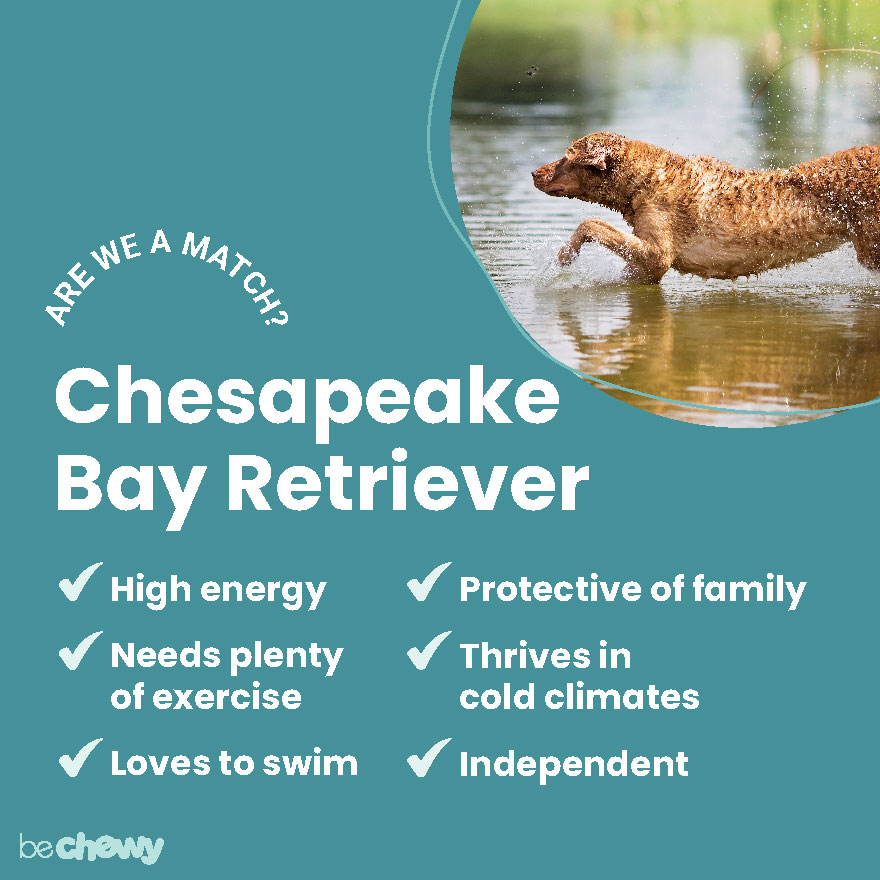
Top Takeaways
Chesapeake Bay Retrievers are high-energy pets who make great companions for experienced and active pet parents. They may need a lot of exercise (like fetch!) and activities to keep them content, but it’s totally worth it. Whether out and about or at home by your feet, these loyal, loving dogs will bond with you for life.
Expert input provided by veterinarian Dr. Rachel Barrack, DVM, CVA, CVCH founder of concierge veterinary practice Animal Acupuncture and Amber Walker, KPA-CTP, zoologist, and owner of Animal Intuitions.
Breed characteristic ratings provided by Dr. Sarah J. Wooten, DVM, CVJ, a veterinarian at Sheep Draw Veterinary Hospital in Greeley, Colorado; dog trainer and behavior consultant Irith Bloom, CPDT-KSA, CBCC-KA, CDBC, owner of The Sophisticated Dog, LLC, in Los Angeles; and certified animal behavior consultant Amy Shojai, CABC, in Sherman, Texas.
The health content was medically reviewed by Chewy vets.
Photo credit for “How do I look?” American Kennel Club

Search for Adoptable Chesapeake Bay Retrievers Near You
Top Chesapeake Bay Retriever Names
These are the top Chesapeake Bay Retriever names as chosen by Chewy's pet parents!
Female Names
- Maggie
- River
- Stella
- Luna
- Molly
- Sadie
- Riley
- Scout
- Oakley
- Daisy
Male Names
- Hank
- Moose
- Duke
- Bear
- Cooper
- Finn
- Ruger
- Cash
- Charlie
- Teddy
Share:



